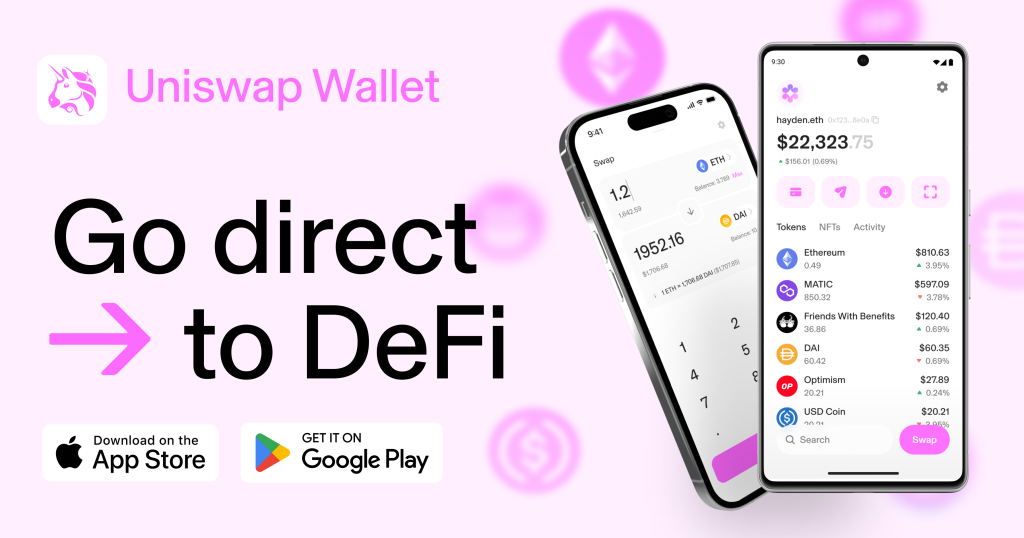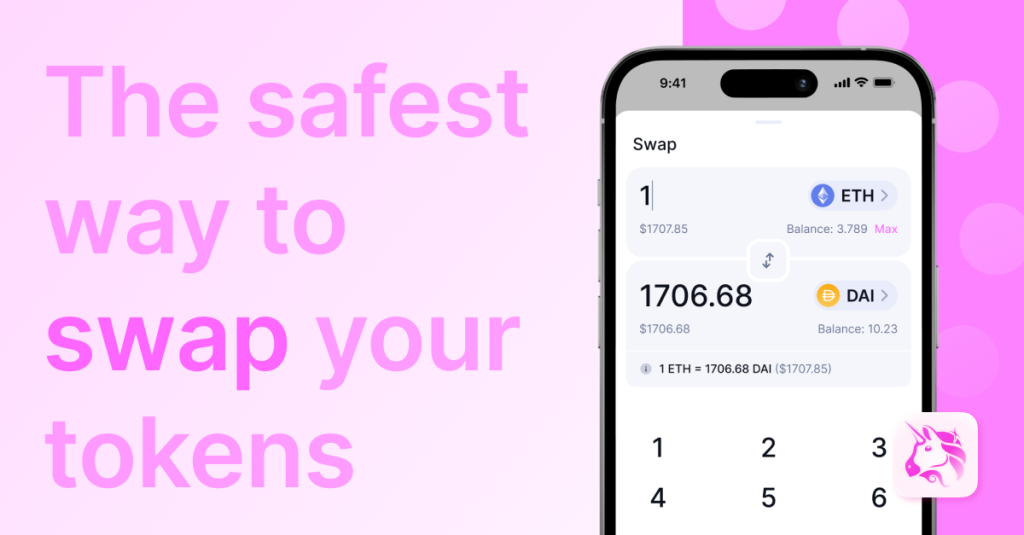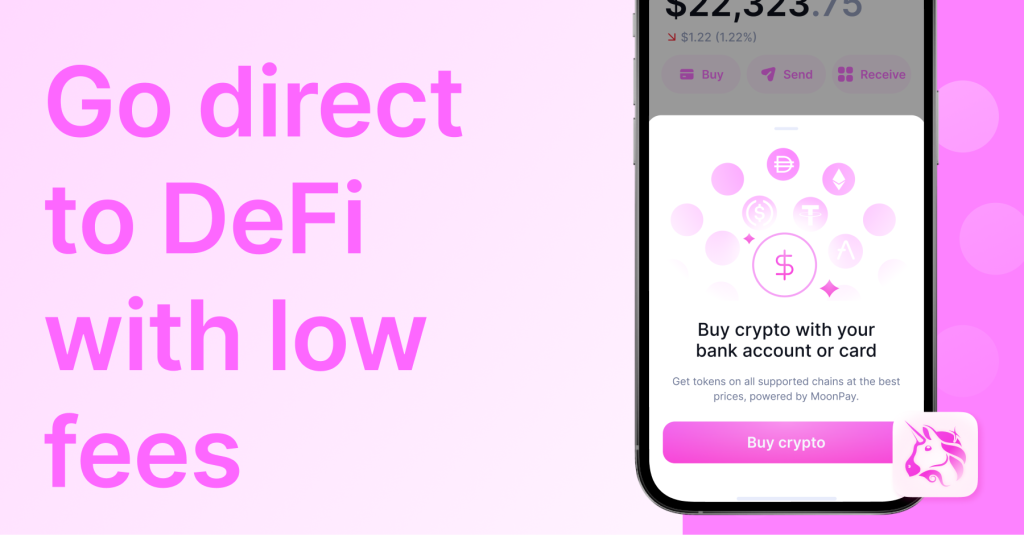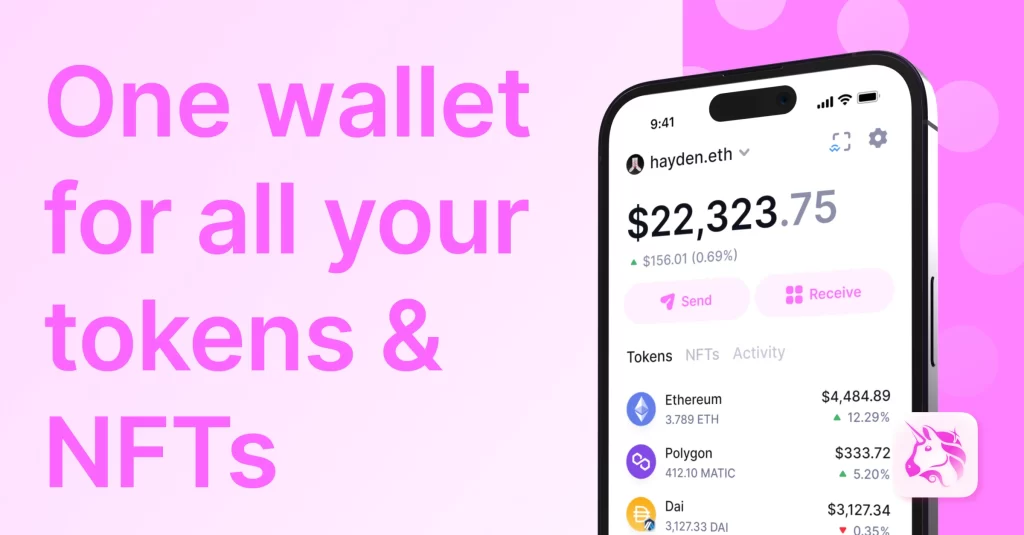
No, Uniswap doesn’t have a desktop wallet, but it works with desktop wallets like MetaMask and Trust Wallet.
Understanding Uniswap Wallet Options
When using Uniswap, selecting the right wallet is crucial for secure and efficient trading. Various wallet types are compatible with Uniswap, each offering unique features and benefits.
Overview of Wallet Types
There are several types of wallets that you can use with Uniswap, each catering to different needs and preferences.
- Browser Extension Wallets: These wallets, such as MetaMask, are added as extensions to your web browser. They offer a convenient way to interact with decentralized applications (dApps) directly from your browser.
- Mobile Wallets: Apps like Trust Wallet provide easy access to your crypto assets on the go. They are user-friendly and support a wide range of cryptocurrencies.
- Desktop Wallets: These wallets are software applications installed on your computer. Examples include Exodus and Atomic Wallet, which offer enhanced security and more control over your assets.
- Hardware Wallets: Devices like Ledger Nano S and Trezor store your private keys offline, providing the highest level of security. They can be integrated with software wallets for convenient access to dApps like Uniswap.
Importance of Wallet Choice
Choosing the right wallet is essential for several reasons, including security, usability, and compatibility with Uniswap.
- Security: Different wallets offer varying levels of security. Hardware wallets provide the highest security by keeping private keys offline, while browser extension wallets offer a balance of convenience and security.
- Usability: Consider how you plan to use Uniswap. If you frequently trade on the go, a mobile wallet might be the best choice. For regular desktop use, browser extension wallets like MetaMask offer seamless integration.
- Compatibility: Ensure the wallet you choose supports Ethereum and ERC-20 tokens, as these are necessary for interacting with Uniswap. Additionally, check if the wallet integrates well with Uniswap to ensure smooth transactions.

Desktop Wallets for Uniswap
Using a desktop wallet for Uniswap offers enhanced security and control over your crypto assets. Desktop wallets are software applications installed on your computer, providing a secure environment for managing and trading cryptocurrencies.
Popular Desktop Wallets
Several desktop wallets are popular among Uniswap users due to their features and reliability.
- MetaMask: While primarily known as a browser extension, MetaMask also offers a desktop version that provides seamless integration with Uniswap and other dApps.
- Exodus: Exodus is a user-friendly desktop wallet that supports a wide range of cryptocurrencies, including Ethereum and ERC-20 tokens. It offers an intuitive interface and built-in exchange features.
- Atomic Wallet: Atomic Wallet supports over 500 cryptocurrencies and provides decentralized exchange services. It is known for its robust security features and user-friendly interface.
- Trust Wallet: Trust Wallet has a desktop version that supports Ethereum and ERC-20 tokens. It is known for its simplicity and security, making it a popular choice for beginners and experienced users alike.
Features of Desktop Wallets
Desktop wallets offer a range of features that make them suitable for managing and trading cryptocurrencies on Uniswap.
- Enhanced Security: Desktop wallets store your private keys on your computer, providing better security compared to online wallets. They often include encryption and backup features to protect your assets.
- User-Friendly Interfaces: Many desktop wallets, like Exodus and Atomic Wallet, offer intuitive and visually appealing interfaces, making it easy to manage and trade your crypto assets.
- Multi-Currency Support: Desktop wallets typically support a wide range of cryptocurrencies, including Ethereum and ERC-20 tokens, ensuring compatibility with Uniswap and other DeFi platforms.
- Built-In Exchange Features: Some desktop wallets, such as Exodus, include built-in exchange functionalities, allowing you to trade cryptocurrencies directly within the wallet.
- Backup and Recovery Options: Desktop wallets provide robust backup and recovery options, ensuring you can restore your wallet if your computer is lost or damaged.
How to Use MetaMask on Desktop
MetaMask is one of the most popular wallets for interacting with decentralized applications (dApps) like Uniswap. Here’s how to use MetaMask on your desktop, from installation to setup.
Installing MetaMask Extension
MetaMask is available as a browser extension for Chrome, Firefox, and other popular browsers. Follow these steps to install MetaMask:
- Visit the MetaMask Website: Go to the official MetaMask website (metamask.io) to ensure you are downloading the correct extension.
- Choose Your Browser: Select your preferred browser (e.g., Chrome, Firefox) and click on the appropriate link to visit the browser’s extension store.
- Install the Extension: Click on the “Add to [Browser]” button. Follow the prompts to install the extension. Once installed, the MetaMask icon will appear in your browser’s toolbar.
Setting Up MetaMask
After installing MetaMask, you need to set it up to use it with Uniswap and other dApps. Here’s how:
- Create a New Wallet: Click on the MetaMask icon in your browser’s toolbar to open the extension. Click on “Get Started” and then select “Create a Wallet.”
- Set a Password: Create a strong password for your MetaMask wallet. This password will be used to unlock the wallet on your device.
- Backup Your Seed Phrase: MetaMask will generate a 12-word seed phrase. Write this phrase down and store it in a secure location. This seed phrase is crucial for recovering your wallet if you lose access to your device.
- Confirm Your Seed Phrase: MetaMask will ask you to confirm your seed phrase by selecting the words in the correct order. This step ensures that you have correctly noted the seed phrase.
- Complete Setup: Once you have confirmed your seed phrase, your MetaMask wallet is set up and ready to use.

Connecting MetaMask to Uniswap
To trade on Uniswap using MetaMask, you need to link your MetaMask wallet to the Uniswap platform. This connection enables you to interact with Uniswap’s decentralized exchange features directly from your browser.
Linking MetaMask to Uniswap
Linking your MetaMask wallet to Uniswap is a straightforward process. Follow these steps:
- Open MetaMask: Ensure your MetaMask wallet is installed and set up in your browser. Unlock your wallet using your password.
- Visit Uniswap: Navigate to the official Uniswap website (uniswap.org) and click on the “Launch App” button to access the Uniswap interface.
- Connect Wallet: In the Uniswap interface, click on the “Connect Wallet” button located in the top right corner of the page.
- Select MetaMask: From the list of wallet options, choose “MetaMask.” A MetaMask pop-up will appear, prompting you to connect your wallet to Uniswap.
- Authorize Connection: In the MetaMask pop-up, select the account you wish to connect (if you have multiple accounts) and click “Next.” Then, click “Connect” to authorize the connection between MetaMask and Uniswap.
- Confirmation: Once connected, you will see your wallet address displayed in the top right corner of the Uniswap interface, indicating a successful connection.
Trading with MetaMask on Uniswap
With your MetaMask wallet linked to Uniswap, you can now start trading cryptocurrencies. Here’s how to execute a trade:
- Select Tokens: In the Uniswap interface, go to the “Swap” tab. In the “From” field, select the token you want to trade (e.g., ETH). In the “To” field, select the token you want to receive (e.g., USDC).
- Enter Amount: Enter the amount of the token you want to trade in the “From” field. The corresponding amount of the token you will receive will automatically be calculated and displayed in the “To” field.
- Review Trade Details: Check the details of the trade, including the exchange rate, slippage tolerance, and the estimated gas fee. Ensure everything is correct before proceeding.
- Approve Token: If you are trading a token other than ETH for the first time, you will need to approve it. Click on the “Approve [Token]” button. MetaMask will prompt you to confirm the approval. Confirm the transaction in MetaMask.
- Confirm Swap: After approving the token, click on the “Swap” button. A confirmation window will appear with the trade details. Review the details and click “Confirm Swap.”
- Confirm in MetaMask: MetaMask will prompt you to confirm the swap and pay the gas fee. Review the transaction details and click “Confirm.”
- Wait for Confirmation: The transaction will be submitted to the Ethereum network. You can track its progress in MetaMask or on a blockchain explorer like Etherscan. Once confirmed, the swapped tokens will appear in your MetaMask wallet.

Other Desktop Wallets Compatible with Uniswap
In addition to MetaMask, there are several other desktop wallets that are compatible with Uniswap. These wallets offer different features and levels of security, making them suitable for a variety of users.
Trust Wallet Desktop App
Trust Wallet is a widely used mobile wallet, but it also offers a desktop application that provides robust security and user-friendly features.
- Installation: Download the Trust Wallet desktop app from the official Trust Wallet website. Follow the installation instructions for your operating system.
- Setup: Create a new wallet or import an existing one using your seed phrase. Ensure you securely store your seed phrase for recovery purposes.
- Connecting to Uniswap: Open the Trust Wallet desktop app and navigate to the dApps browser. Visit the Uniswap website (uniswap.org) and connect your wallet following the on-screen instructions. Trust Wallet integrates seamlessly with Uniswap, allowing you to trade directly from your desktop.
- Features: Trust Wallet offers support for a wide range of cryptocurrencies, a user-friendly interface, and built-in staking and DeFi services, making it a versatile choice for Uniswap users.
Ledger Live Integration
Ledger Live is the software companion to Ledger hardware wallets, providing an extra layer of security by storing your private keys offline.
- Installation: Download Ledger Live from the official Ledger website and install it on your desktop. Follow the setup instructions to configure your Ledger hardware wallet.
- Setup: Connect your Ledger hardware wallet to your computer using a USB cable. Open Ledger Live and follow the prompts to set up your wallet. Ensure your device firmware is up to date.
- Connecting to Uniswap: To use Uniswap with Ledger Live, you will need to connect your Ledger wallet via MetaMask. Install the MetaMask extension in your browser and set it up. In MetaMask, select “Connect Hardware Wallet,” choose “Ledger,” and follow the instructions to link your Ledger device.
- Features: Ledger Live offers high security by keeping your private keys offline. It supports a wide range of cryptocurrencies and provides detailed portfolio tracking. When connected to MetaMask, you can use Uniswap with the added security of a hardware wallet.

Security Tips for Desktop Wallets
Ensuring the security of your desktop wallet is crucial for protecting your crypto assets. Here are essential tips and best practices to keep your desktop wallet secure and manage your passwords effectively.
Keeping Your Desktop Wallet Secure
Securing your desktop wallet involves several proactive steps to safeguard your assets from potential threats.
- Use Strong Passwords: Create a unique, complex password for your wallet that includes a mix of letters, numbers, and special characters. Avoid using easily guessable information.
- Enable Two-Factor Authentication (2FA): If your wallet or related accounts support 2FA, enable it to add an extra layer of security. This requires a second form of verification in addition to your password.
- Keep Your Software Updated: Regularly update your wallet software and any related applications. Updates often include security patches that protect against new vulnerabilities.
- Install Reliable Antivirus Software: Use reputable antivirus software to protect your computer from malware and other security threats that could compromise your wallet.
- Backup Your Wallet: Regularly back up your wallet’s private keys or seed phrases. Store backups in multiple secure locations, such as encrypted USB drives or external hard drives.
- Be Cautious with Phishing Attempts: Be vigilant about phishing scams. Always verify URLs and avoid clicking on suspicious links. Ensure you are on the official website when accessing your wallet or related services.
- Use a Hardware Wallet: For enhanced security, consider using a hardware wallet in conjunction with your desktop wallet. Hardware wallets keep your private keys offline, significantly reducing the risk of hacks.
Best Practices for Password Management
Managing your passwords effectively is critical for maintaining the security of your desktop wallet.
- Use a Password Manager: Utilize a reputable password manager to generate and store complex passwords securely. This reduces the risk of forgetting passwords and ensures they are strong and unique.
- Avoid Reusing Passwords: Never use the same password across multiple accounts. Each account, especially your crypto wallet, should have a unique password.
- Regularly Update Passwords: Change your passwords periodically to enhance security. Immediately update passwords if you suspect any compromise.
- Memorize Critical Passwords: While a password manager is useful, memorize the passwords for your most critical accounts, such as your primary wallet password.
- Enable Biometric Security: If your device supports biometric authentication (e.g., fingerprint or facial recognition), use it as an additional security measure for accessing your wallet.

Alternatives to Desktop Wallets
If you prefer not to use a desktop wallet, there are other secure and convenient options available. Mobile wallets and hardware wallets are excellent alternatives, each offering unique benefits for managing and trading your crypto assets.
Mobile Wallet Options
Mobile wallets provide the convenience of managing your crypto assets on the go. They are user-friendly and accessible from your smartphone.
- Trust Wallet: Trust Wallet is a highly popular mobile wallet that supports a wide range of cryptocurrencies, including Ethereum and ERC-20 tokens. It offers a simple interface, built-in dApps browser, and integration with Uniswap.
- Coinbase Wallet: Coinbase Wallet allows you to securely store your crypto assets and interact with dApps. It supports multiple cryptocurrencies and provides easy access to Uniswap for trading.
- MetaMask Mobile: The mobile version of MetaMask offers the same functionality as its desktop counterpart. It allows you to manage your assets, connect to dApps, and trade on Uniswap directly from your smartphone.
- Mycelium: Known for its strong security features, Mycelium is a versatile mobile wallet that supports Bitcoin, Ethereum, and ERC-20 tokens. It offers advanced privacy features and integration with hardware wallets.
Hardware Wallet Integration with Uniswap
Hardware wallets provide the highest level of security by keeping your private keys offline. They can be integrated with software wallets to interact with Uniswap.
- Ledger Nano S and Ledger Nano X: Ledger hardware wallets are renowned for their security. They support a wide range of cryptocurrencies and can be integrated with MetaMask for use with Uniswap. Simply connect your Ledger device to your computer, open MetaMask, and select “Connect Hardware Wallet.”
- Trezor Model T and Trezor One: Trezor wallets offer top-tier security and support for multiple cryptocurrencies. Similar to Ledger, they can be integrated with MetaMask to trade on Uniswap. Connect your Trezor device, open MetaMask, and follow the prompts to link your wallet.
- KeepKey: KeepKey is another secure hardware wallet that can be used with Uniswap through integration with MetaMask. It offers a large display for easy transaction verification and supports a variety of cryptocurrencies.